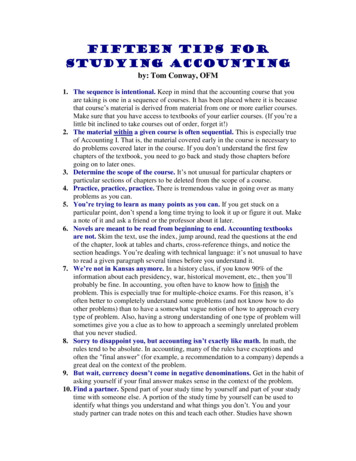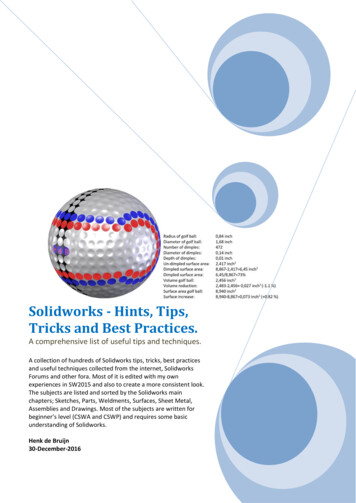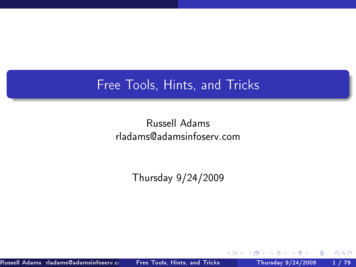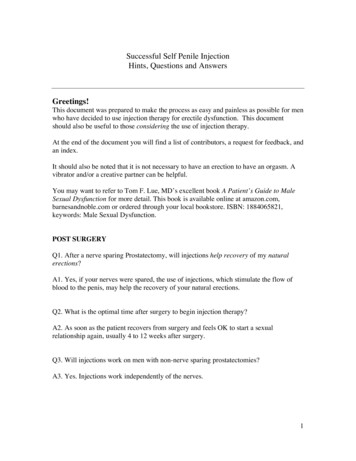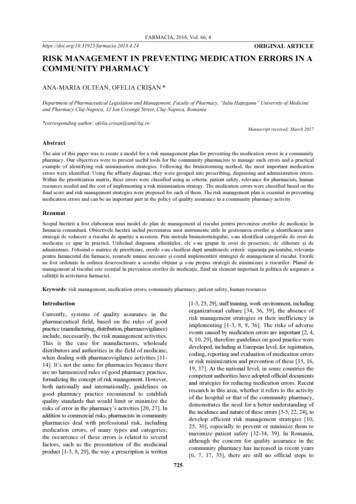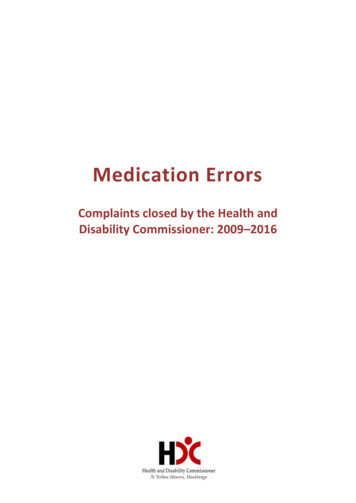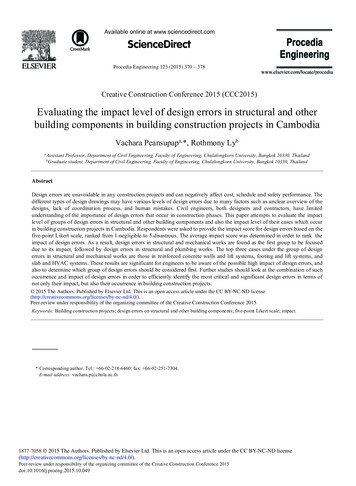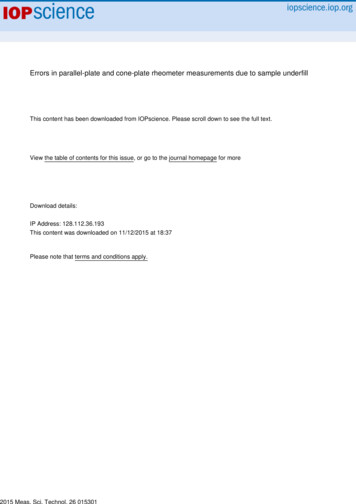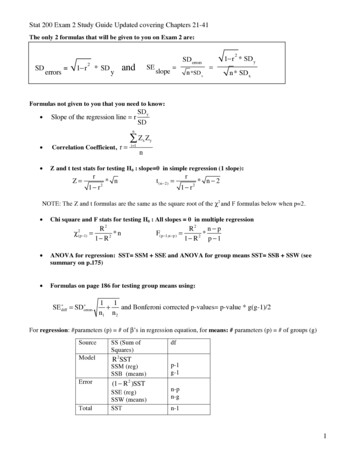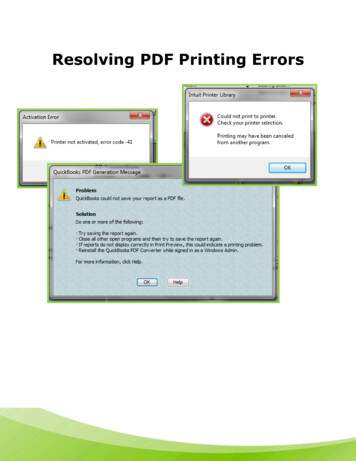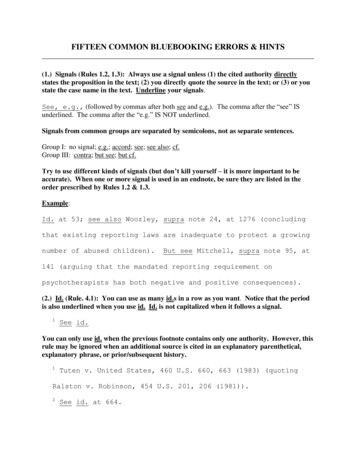
Transcription
FIFTEEN COMMON BLUEBOOKING ERRORS & HINTS(1.) Signals (Rules 1.2, 1.3): Always use a signal unless (1) the cited authority directlystates the proposition in the text; (2) you directly quote the source in the text; or (3) or youstate the case name in the text. Underline your signals.See, e.g., (followed by commas after both see and e.g.). The comma after the “see” ISunderlined. The comma after the “e.g.” IS NOT underlined.Signals from common groups are separated by semicolons, not as separate sentences.Group I: no signal; e.g.; accord; see; see also; cf.Group III: contra; but see; but cf.Try to use different kinds of signals (but don’t kill yourself – it is more important to beaccurate). When one or more signal is used in an endnote, be sure they are listed in theorder prescribed by Rules 1.2 & 1.3.Example:Id. at 53; see also Woozley, supra note 24, at 1276 (concludingthat existing reporting laws are inadequate to protect a growingnumber of abused children).But see Mitchell, supra note 95, at141 (arguing that the mandated reporting requirement onpsychotherapists has both negative and positive consequences).(2.) Id. (Rule. 4.1): You can use as many id.s in a row as you want. Notice that the periodis also underlined when you use id. Id. is not capitalized when it follows a signal.1See id.You can only use id. when the previous footnote contains only one authority. However, thisrule may be ignored when an additional source is cited in an explanatory parenthetical,explanatory phrase, or prior/subsequent history.1Tuten v. United States, 460 U.S. 660, 663 (1983) (quotingRalston v. Robinson, 454 U.S. 201, 206 (1981)).2See id. at 664.
(3.) Reporters: Always check the blue pages in the back of the bluebook (Table 1) toensure that the spacing of reporters is correct.S. Ct. [one space]F. Supp. [one space]F.2d [no space](4.) Pin Cites: All citations must include a pin cite, unless the citation is merely providingthe citation for a full case name in text or the citation is a see generally cite in which theentire source makes the point referred to in text.In Tarasoff v. Regents of the University of California,13 thecourt held . . .13551 P.2d 334 (Cal. 1976).(5.) Page Numbers: When citing multiple pages, give the inclusive page numbers andretain the last two digits of each page, but drop other repetitious digits (Rule 3.2(a)).535-37NOT: 535-537.NOT: 535-71066-79NOT: 1066-1079(6.) Order of Authorities: In all footnotes that contain more than one source following asingle signal, you must check the citations according to the order of authorities chart in thebluebook (Rule 1.4). For example, several cases following a see signal must be placed in orderaccording to court, chronology, and sometimes alphabetically. All types of sources are subject tothis ordering rule, including law review articles and statutes.(7.) Supra & hereinafter: Once an authority (meaning articles, books, etc. but not cases,statutes, constitutions, legislative materials, etc.) has been cited once in full, it is thereafterreferred to with a supra cite (Rule 4.2).23See Carla S. Copeland, The Use of Arbitration to SettleTerritorial Disputes, 67 Fordham L. Rev. 3073, 3075 (1999).* * *58Copeland, supra note 23, at 3077.“Hereinafter” should be used in the following circumstances (Rule 4.2(b)):(1) The authority is too cumbersome to cite with the usual supra form.
(2) The supra form would be confusing to the reader, for instance when there is morethan one piece by an author in a footnote. In this situation, the hereinafter cite shouldinclude the author’s last name, followed by a comma and the underlined title of thework, which can be in shortened form.The hereinafter parenthetical immediately follows the first full citation and is enclosed inbrackets.23See Judith Resnik, The Domain of the Courts, 137 U. Pa. L.Rev. 2219, 2221-22 (1989) [hereinafter Resnik, The Domain of theCourts]; Judith Resnik, Failing Faith:Adjudicatory Procedurein Decline, 53 U. Chi. L. Rev. 494, 518-20 (1986) [hereinafter,Resnik, Failing Faith].* * *67Resnik, The Domain of the Courts, supra note 23, at 2229.(8.) Case Names and Abbreviations: The abbreviation of case names is governed by Rule10.2. Every case name must be checked against the abbreviations chart in the bluebook(Table T.6)—many words in cases can (and should) be abbreviated! Note that in footnotes,words other than the first word in each party’s name are subject to the abbreviation rule. In text,however, only words such as Co., Corp., and Inc. can be abbreviated (Rule 10.2.1(c)).14Global Engineering Enterprises v. Universal EnvironmentalBuilding Corporation, . . .Becomes:14Global Eng’g Enters. v. Universal Envtl. Bldg. Corp., . . .Underline case names IN TEXT (no italics) and always give the full case name the first timeyou cite it.When citing a case name IN FULL, do NOT underline the case name IN THE ENDNOTE(Rule 10.2).23See Bush v. Gore, 531 U.S. 98, 105 (2000).(9.) Short Cites: A case or statute should be short-cited if it appears within the fiveprevious endnotes. Note that Id. counts as a citation to the case or statute. Otherwise, a
full case name or statute citation must be used (Rules 4.1 & 10.9(b)). When using a shortcite for a case, underline the part of the case name comprising the short cite (Rule 10.9).1Esercizio v. Roberts, 944 F.2d 1235, 1245 (6th Cir. 1991).2Syntax Labs., Inc. v. Norwich Pharmacal Co., 437 F.2d 566, 568(2d Cir. 1971).3See id. at 570.428 U.S.C. § 1292(b) (1994).5Stephen Ellmann, Truth and Consequences, 69 Fordham L. Rev.895, 924-28 (2000).6See infra note 88 and accompanying text.7See Ellmann, supra note 5, at 899.8Syntax, 437 F.2d at 570.[Id. short cite appears w/in the previous 5 footnotes,so use the short cite here.]9See 28 U.S.C. § 1292(b).[Statute was cited w/in the previous 5 footnotes, sodrop the date.]10Esercizio v. Roberts, 944 F.2d 1235, 1243 (6th Cir. 1991).[Last cite was 9 cites earlier, so give the full cite.](10.) According to the Bluebook, law review article titles are italicized. Underlining also isacceptable and must be used exclusively in the Unified Writing Competition. OrdinaryCourier New-12 pt. type for the title of the journal must be used in place of LARGE/SMALLCAPS.13John Czarnetzky, Time, Uncertainty, and the Law ofCorporate Reorganizations, 67 Fordham L. Rev. 2939, 2942-43(1999).See Table 13 in the back of the Bluebook for the correct abbreviations of periodical titles.
(11.) Spacing in Endnotes: In endnotes, citation sentences begin one space after a textualproposition. But if you begin a new sentence after a citation, that new sentence will be twospaces after the citation.34See Bush, 531 U.S. at 103. [two spaces] The Court alsodiscussed the fundamental nature of the right to vote and theequal weight given to each vote. [one space] Id. at 104.(12.) Parentheticals: Try to include parentheticals whenever possible to describe to yourreader what the case held or why it is pertinent to the discussion. Try to acclimate thereader and make it very easy for him or her to understand why you are citing to this sourceas opposed to any other.Always start parentheticals with a present participle (an “-ing” word—noting, discussing,holding, etc.) unless the entire parenthetical is a quotation.Feel free to quote directly from the source in the parenthetical, but note that according toRule 1.5, citation style differs depending on whether the entire parenthetical is thequotation, or whether the quotation comprises only a small part of the parenthetical:(“The Writing Competition is extremely fun.”).(noting that competing for a staff position on a journal “isextremely fun”).(13.) Quotations: Make sure that you quote exactly—the editors will be checking! Checkthe Bluebook for the rules on quotations (they are pretty straightforward) (Rule 5).If you need to cite a source that is quoted or cited in a source provided in the packet, followthis format:See Bush v. Gore, 531 U.S. 98, 107 (2000) (citing Moore v.Ogilvie, 394 U.S. 814, 819 (1969)).(14.) Statutes: The Bluebook does a pretty good job of giving examples of the particularstatute you may be citing. Use the Index. For state statutes, see Table 1 of the Bluebook. Ifyou use “id.” with a statute, do not use the word “at” as you do with cases (Rule 12.9).142 U.S.C. § 2004 (1994).2See id. § 2006.NOT:See id. at § 2006.
(15.) Internal Cross-Referencing: You will likely need to refer to endnotes or entiresections of your Note throughout the paper (Rules 3.6 & 4.2). To do this, use the wordssupra (above) or infra (below):14For a further discussion of this issue, see infra notes 24-29 and accompanying text.71See supra notes 53-57 and accompanying text.In the first example, “see” is not underlined because it is part of a grammatical sentence(used as a verb) and is not being used as a signal (Rule 1.2(e)).
FIFTEEN COMMON BLUEBOOKING ERRORS & HINTS (1.) Signals (Rules 1.2, 1.3): Always use a signal unless (1) the cited authority directly states the proposition in the text; (2) you directly quote the source in the text; or (3) or you state the case name in the text. Underline your signals. See, e.g., (followed by commas after both see and e.g.). The comma after the “see” IS underlined. The .
